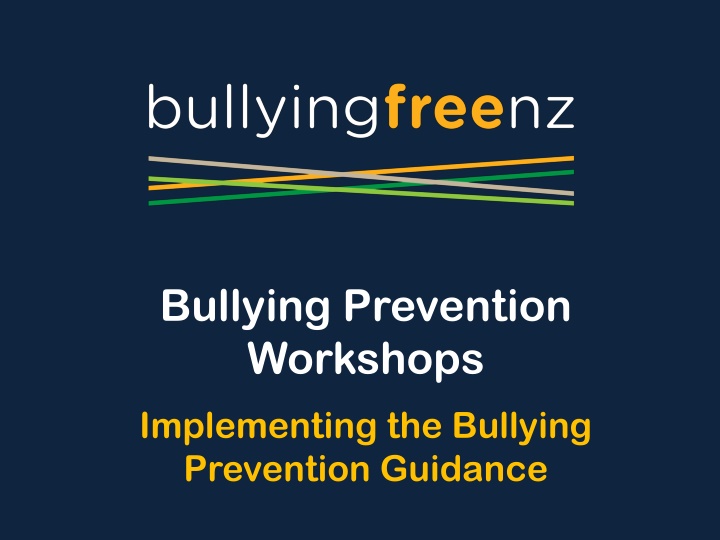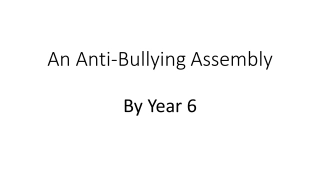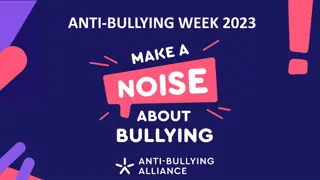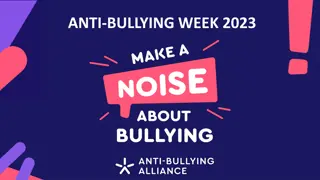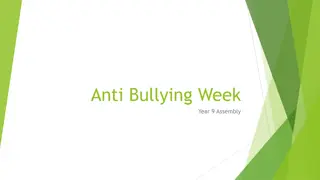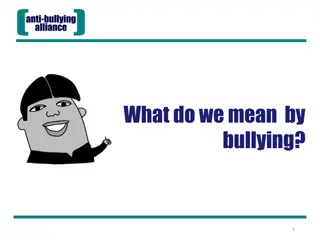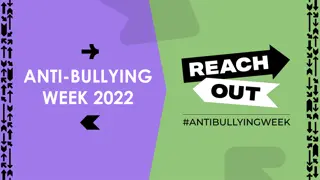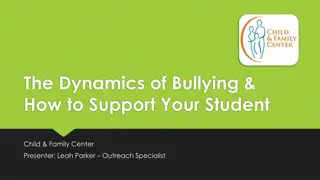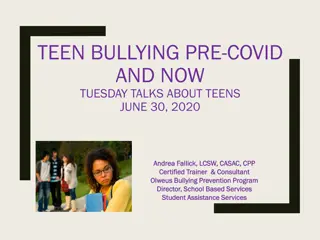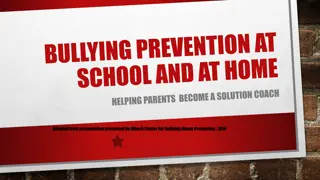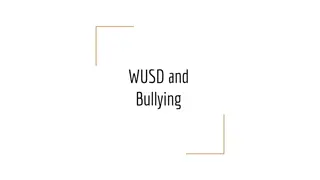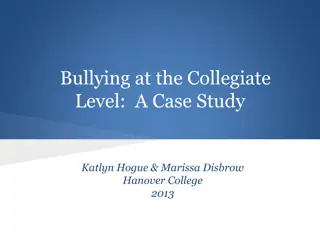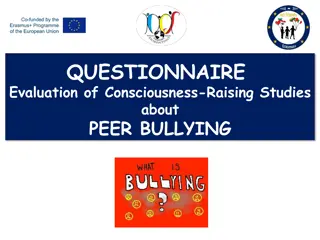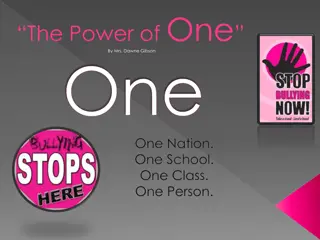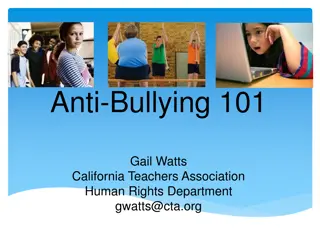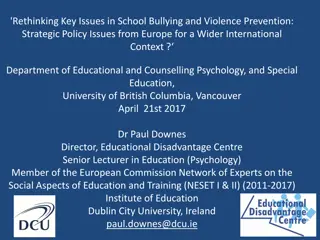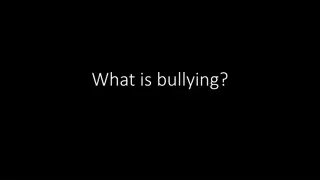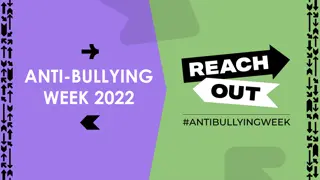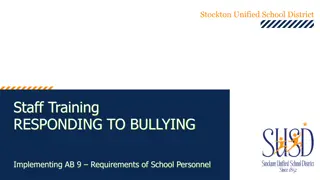Effective Bullying Prevention Workshops for Schools
Comprehensive Bullying Prevention Workshops designed to empower educators in implementing guidance for preventing and addressing bullying in schools. The workshops cover topics such as defining bullying, types of bullying, and fostering a shared understanding within the school community. Participants engage in discussions, activities, and reflections to enhance their ability to create a safe and inclusive school environment.
Download Presentation

Please find below an Image/Link to download the presentation.
The content on the website is provided AS IS for your information and personal use only. It may not be sold, licensed, or shared on other websites without obtaining consent from the author.If you encounter any issues during the download, it is possible that the publisher has removed the file from their server.
You are allowed to download the files provided on this website for personal or commercial use, subject to the condition that they are used lawfully. All files are the property of their respective owners.
The content on the website is provided AS IS for your information and personal use only. It may not be sold, licensed, or shared on other websites without obtaining consent from the author.
E N D
Presentation Transcript
Bullying Prevention Workshops Implementing the Bullying Prevention Guidance
Workshops overview The following slides are designed to support the delivery of professional development activities for schools through the 10 Bullying Prevention Workshops available on www.bullyingfreeNZ.co.nz The materials for each of the workshops will include information about which slides to use for each workshop. Trainer Slide
What is Bullying? Discuss the question of what is bullying with your group. Try to come to a consensus on three short statements describing what bullying behaviours look like as they understand it or see it. Try to make the statements no longer than three words. Record these statements on post-it notes or a poster to be displayed in the room and referred to later in the session, Workshop 1
Definition of Bullying Bullying is deliberate Bullying involves a power imbalance Bullying has an element of repetition Bullying is harmful Workshops 1 & 2
Defining bullying in your school Use the bullying prevention guide (p11) to look at the definition of bullying and discuss: What definition do you have in your school? How could you have a wider discussion with staff and families, wh nau and community regarding a shared understanding of bullying? Workshop 1
Types of Bullying physical world Verbal e.g. snide asides, threats, put- downs (hidden) Verbal e.g. discriminatory remarks, threats, name-calling (in view) Physical e.g. standover behaviour, holding, hitting (hidden) Physical e.g. standover behaviour, holding, hitting (in view) Social/ relational e.g. spreading rumours or personal information Social/ relational e.g. openly excluding from peer group, ostracising covert overt Verbal e.g. emails, texts, anonymous comments / post things Verbal e.g. posting negative photos / comments on website Physical e.g. anonymous defacing webpage or profile page Physical e.g. defacing webpage or profile page Social/ relational e.g. posting negative material anonymously Social/ relational e.g. exclusion from activities, ostracising Digital world (cyberbullying) Workshop 1
What does defiance look like? Spend 1 minute writing down your own individual definition / description Then discuss in groups how similar are your definitions? Workshop 2
Preventing Bullying Policy Bullying behavior is likely to be occurring in all schools, whether or not we are aware of it. To meet the NAG 5 requirements for a safe physical and emotional school environment, all schools should have a policy that defines bullying and sets out how the school community will address it. This can be a standalone policy or part of an overarching behavior or safe school policy. Policy will include cyberbullying and will be part of a school s wider approach to promoting social wellbeing and positive student interactions. It should clearly state that the school does not accept bullying. Workshop 3
Preventing Bullying Policy Teachers, students, parents and wh nau should all have an opportunity to have input into their school s policies on bullying (as well as the strategies in place to build students social competencies). A school s policy will support decision-making that takes place when bullying occurs, but will need to be reviewed regularly to ensure its ongoing effectiveness. As part of its role, the Education Review Office (ERO) will review a school s bullying policy and practice using self-review questions to make sure school policies and practice align. Workshop 3
Initiators and Targets Initiators Students who bully others often to gain peer recognition and status. Bullying behaviour is reinforced when they intimidate their targets and when peers colludes by not challenging or reporting the bullying. Targets All ages can be at greater risk of being targets for many reasons including: being unassertive or withdrawn e.g. isolated with low self-esteem differing from the majority culture ethnicity, cultural or religious background, sexual orientation, gender identity, or socio-economic status having a disability, special education needs or mental health issues academic achievement (perceived as high or low achiever). Workshop 4
Bystander roles Followers (Assistants): do not initiate, but take an active role in the bullying behaviour. Supporters (Reinforcer): Support the bullying behaviour (overtly or covertly, e.g. by turning a blind eye), but do not take an active role in the bullying behaviour. Defenders: dislike the bullying and try to help the target by intervening, getting teacher support (using safe telling) or providing direct support to the target. Workshop 4
Bystander behaviours Who s typically involved in a bullying incident? 7% assistants of initiator 17% defenders of the target 8% initiator 12% target 20% reinforcers of initiator 24% outsiders (Salmivalli et al, 1996) Workshop 4
Strategies for dealing with bullying Preventing Responding Direct teaching Restorative methods Developing a School ethos Method of Shared Concern / Undercover teams / Problem solving teams Solution Focused Discussions Developing an anti-bullying policy Wellbeing in schools survey School sanction systems Peer mediation Outside agencies Workshops 5 & 6
Preventing bullying and the curriculum For maximum impact, bullying prevention approaches should align with good teaching practice and the New Zealand Curriculum/Te Marautanga o Aotearoa, e.g. as part of teaching key competencies: managing self self-motivation, a can-do attitude, and students seeing themselves as capable learners relating to others interacting effectively with a diverse range of people in a variety of contexts participating and contributing being actively involved in communities, including family, wh nau, school and groups based on a common interest or culture. Workshop 5
Activity: Responding to bullying Use the Responses to Behaviour handout and the bullying scenarios sheet to discuss possible different responses to the scenarios. Workshop 6
Responding to bullying Workshop 6
Preventing bullying and the curriculum For maximum impact, bullying prevention approaches should align with good teaching practice and the New Zealand Curriculum/Te Marautanga o Aotearoa. Teaching key competencies managing self self-motivation, a can-do attitude, and students seeing themselves as capable learners relating to others interacting effectively with a diverse range of people in a variety of contexts participating and contributing being actively involved in communities, including family, wh nau, school and groups based on a common interest or culture. Workshop 7
Preventing bullying and the curriculum Health and Physical Education Bullying approaches should also align with the Health and Physical Education (HPE) learning area of the curriculum. Students are encouraged to demonstrate empathy and develop skills that enhance relationships (see the relationships with other people strand). Students learn to take responsible and critical action to contribute to healthy communities and environments (see the healthy communities and environments strand). The underlying principles of tolerance and respect for others can be woven into all aspects of teaching and learning. Workshop 7
What is cyberbullying? Cyberbullying is one particular form of bullying, but it doesn t sit on its own. It is bullying that is enabled, enhanced, or in some way mediated through digital technology. Digital technology can be a medium for all kinds of bullying behaviour, including physical, verbal and social / relational bullying and with its increasingly important role in young people s lives, cyberbullying is becoming more prevalent. Email, cell phones, chat rooms, social networking sites and instant messaging can all be used to bully others verbally, socially or psychologically. Workshop 8
Characteristics of cyberbullying? The characteristics of bullying behaviour may be expressed differently in the context of cyberbullying. repetition can be influenced by the ability of a single action to spread and be repeated rapidly to a wider audience and with a degree of permanence (e.g. forwarding texts) power imbalance can also be a function of the anonymity of initiator, or of an ability to use technology (as opposed to traditional age, physical strength and social status imbalances) cyberbullying can involve people who have never physically met and / or people who share no common acquaintances. Workshop 8
Examples of cyberbullying Examples of cyberbullying include: sending abusive texts or emails posting negative or inappropriate messages or images on social networking sites taking and sharing private images, including sexual images forming bullying groups on social networking sites assuming the identity of a target online and representing them in a way that may be harmful to them or cause them distress. Workshop 8
Cyberbullying and other forms of bullying In many ways cyber bullying is like any other form of bullying. Cyberbullying may occur alongside bullying in a physical environment which would intensify the effect. E.g. recording and distributing a bullying incident on a smartphone. One study found children who were bullied offline were 15 times more likely to be bullied online*. Equally students who are experiencing cyberbullying are likely to also be experiencing other forms of bullying. *Hasebrink, U., Livingstone, S.l, & Haddon, L. (2008) Comparing children s online opportunities and risks across Europe: Cross-national comparisons for EU Kids. Online article. Workshop 8
Working with parents and whanau There are three aspects to working with parents in relation to bullying. 1. Keep parents informed of the school policy including: the school s definition of bullying all the ways in which the school works to prevent bullying the school policy for responding to bullying Workshop 9
Working with parents and whanau 2. Including parents in interventions and problem solving, e.g.: Restorative practices Method of shared concern Workshop 9
Working with parents and whanau 3. Sign-post parents to other area of information and support, e.g.: NetSafe for concerns regarding digital use A clear complaints procedure showing how parents can speak to the Board of Trustees if necessary Workshop 9
Providing advice to parents and whanau Information schools could include for parents and carers who suspect a child may be a target of bullying: Stay calm. Work out how to deal with the situation together. Reassure the child they have done the right thing by talking about it. Reassure the child it s not their fault, Reassure the child that parents/carers will work with the school to make things better. Agree on a plan of support for the child. Regularly check in with the child to see how they are. Workshop 9
Providing advice to parents and whanau Information schools could include for parents and carers who suspect a child is bullying others: Talk to the child to get the full story and their point of view. Be clear about what is and is not acceptable behaviour at school and at home. Explain how bullying affects the target, the bystanders and the school environment. Discuss better ways to handle situations where the child may act aggressively. Regularly check in with the child to see how they are doing. Recognise and praise appropriate behaviour. Talk to the school and child s teacher about how they can help. Workshop 9
Providing advice to parents and whanau Information schools could include for parents and carers who suspect a child is a target of cyberbullying: Ask questions about how digital technology is being used. Take an active approach to discussing digital issues with their child. Not to access to technology as a sanction in response to being cyberbullied / cyberbullying. Save all bullying messages and images to use when reporting to the school or Police. Contact the Police if cyberbullying involves physical threats or could put the child in danger. Lodge a complaint with the mobile phone or social networking site provider. Contact NetSafe. Workshop 9
Preventing bullying and data collection One of the key aspects of any bullying prevention programme or intervention is gathering data. This allows schools to gain an understanding of what bullying is occurring, where and when and the frequency of this. It also allows schools to gather baseline data to evaluate the impact following teaching and intervention in bullying prevention. Workshop 10
Ways of collecting data Student and teacher evaluations of specific components e.g Kia Kaha, PBL4 lessons Focus group interviews with selected students, teachers and staff Student and Parent Surveys Parent feedback about preventing bullying policies, materials etc. Statistical Data ( eg. Behaviour Incidences detentions suspensions Anecdotal Feedback and observations from staff Workshop 10
The importance of Student Voice Most bullying behaviours take without the awareness of adults. Student surveys have therefore been the main way to measure the prevalence of bullying - they are considered to be the most robust measure of student bullying behaviours.* Some schools may choose to develop their own surveys to use. However these may not incorporate up to date definitions and types of bullying, and may not be robust enough way to provide data that can be compared over time. *Cornell, D., & Bandyopadhyay, S. (2010). The assessment of bullying. In S. Jimerson, S. Swearer, & D. Espelage (Eds.), Handbook of bullying in schools: An international perspective (pp. 265 276). New York: Routledge. Workshop 10
The importance of Student Voice When should student surveys be carried out? Student surveys measuring experiences of bullying in school should be carried out annually. Ideally at the same time of year to provide a comparable time period. Best time to carry out the survey is after peer groups have formed in NZ, Term 2 rather than Term 1. Other data such as behaviour incident reports can be collected and analysed more frequently. Workshop 10
